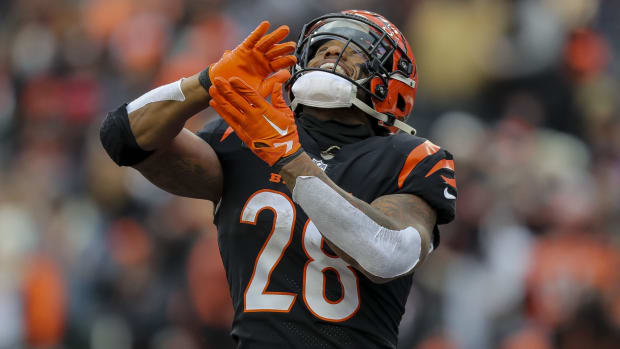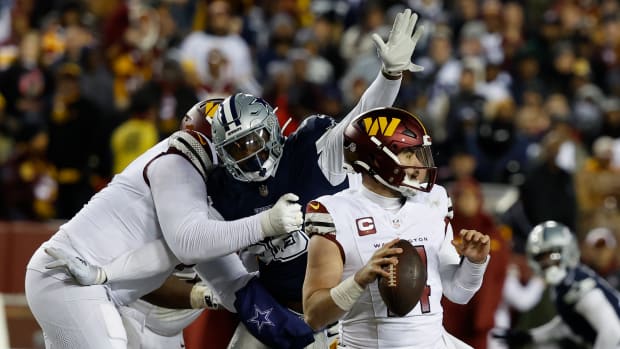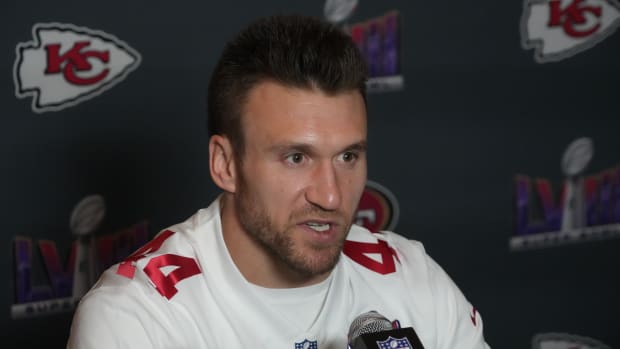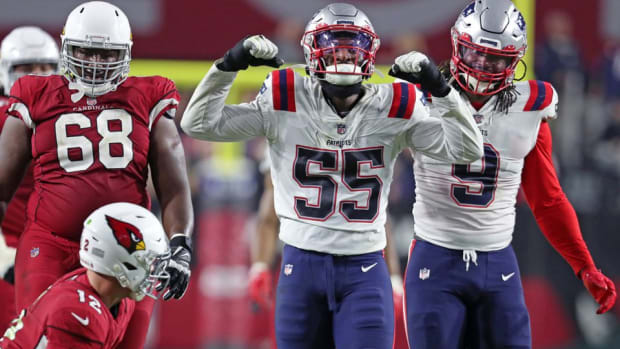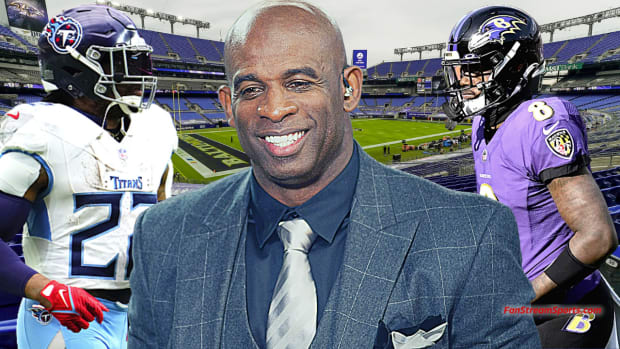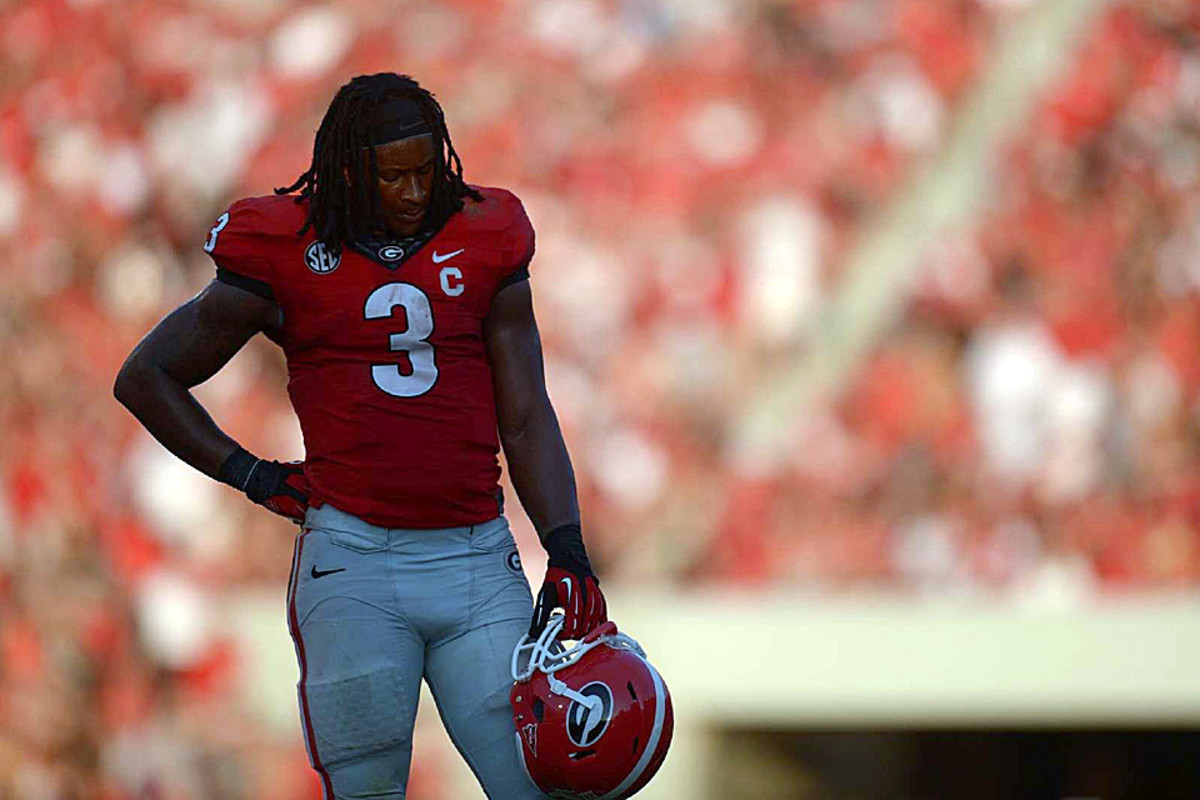
Coming Back
Todd Gurley’s road back began with that all-too-familiar sight on football fields: player lying on the turf, clutching his knee in pain, home crowd hushed.
This was last November in the final minutes of Georgia’s victory over Auburn, Gurley's return from a four-game suspension for accepting $3,000 in exchange for autographing memorabilia. He had advanced the ball six yards on his last carry (1.4 below his per-carry average), and 138 yards for the game (14 below his per-game average). On his second-to-last step, though, he had planted his left leg awkwardly. With the ball still cradled in his left arm, he reached his right hand toward his knee, in pain before he even hit the ground.
On the Georgia sideline, receiver Malcolm Mitchell cringed. He had torn his ACL one year earlier—while celebrating a 75-yard touchdown run by Gurley, of all things. He knew right away what had happened to his teammate.
“When I saw it happen, I was terrified for him,” Mitchell says. “I knew how much coming back and playing with the team meant to him. Because of the mistake he made, a lot of opportunities got taken away from him. This was his time to shine. And he was shining.”
Gurley was Georgia’s star running back, but his value to his teammates extended beyond the field: rounding up guys for dinner, to see a movie, to go bowling. On this night, Mitchell returned the favor. He hopped on the cart that drove Gurley off the Sanford Stadium field for the last time because he didn’t want his friend to ride alone.
Gurley was quiet during the ride, processing the fact that one false step ended his collegiate career and left his NFL future clouded. “Before he tore his ACL, Todd Gurley was a top-5 pick, no brainer,” says one veteran NFL offensive coach.
But despite what happened Nov. 15, and despite the fact that a running back hasn’t been taken in the first round since 2012, NFL teams don’t expect Gurley’s unusual talent and skill set to last beyond the first round Thursday night. One team that is strongly considering Gurley believes he is the best running back to come into the NFL since 2007, when Oklahoma’s Adrian Peterson went seventh overall to the Vikings.
Mitchell stayed with Gurley while Georgia’s medical staff examined him in the locker room, doing the simple physical tests that affirmed the ACL tear. Gurley reacted calmly. He turned to his teammate and told him it was time to start rehabbing: “I gotta do what I gotta do to get back.”
* * *
Photo by John Bazemore/AP
James Andrews repaired Gurley’s knee 10 days later, Nov. 25, five months before the draft. At the time, Georgia coach Mark Richt indicated that Gurley had a clean ACL tear, meaning minimal damage to other structures in the knee such as the meniscus, which cushions the knee and protects the articular cartilage. That was good news for his recovery, and different from another elite SEC runner who suffered a major knee injury in 2012. South Carolina’s Marcus Lattimore was never able to play a game in the NFL after dislocating his knee and injuring multiple ligaments in his final college game.
Every player’s rehab is different, but the way Gurley has progressed so far has been encouraging. About a month ago, he began doing certain kinds of field work with Anthony Hobgood, a former Ole Miss fullback and the performance coach at the EXOS training facility in Gulf Breeze, Fla. EXOS is on the campus of the Andrews Institute, where Gurley had his surgery and was doing clinical physical therapy, until he got the green light a month ago to begin full-body performance training with Hobgood.
Their daily two-hour sessions, ongoing for the past month, have two parts: A movement session outdoors on the turf, and then a strength session in the weight room. The movement sessions rebuild the skills he’ll need to use on the football field, with a progression Hobgood explains through a baseball analogy: first you practice swinging off a tee, then you try hitting soft tosses, then you face live pitching.
So far, Gurley has done the first two stages of movement drills. He started with technical drills like marching, skipping or practicing his running form while leaning against a wall, and doing resistance work with sleds. He has also been doing pre-programmed change of direction drills within the last month, in which he runs and shuffles between cones according to instructions given ahead of time.
The final stage, which Gurley has not yet started, will be random movement, where he would have to change direction or accelerate in response to a stimulus, such as a command from his trainer, a flashing light or a hand clap.
The random movement drills train players for what they’ll experience on a football field; it’s the milestone that precedes returning to practice. As of last week, Hobgood hadn’t let Gurley react to random stimuli yet, “not because he can’t,” he says, “but we don’t want to rush.” Gurley will soon be in the custody of a team that will chart the rest of his return, but based on their work, Hobgood says, Gurley would probably be moved to randomized drills in a matter of weeks.
Peter Kingu2019s Draft News
Peter King shares 10 things he's hearing in the lead up to the draft, including notes on La'el Collins, Melvin Gordon and those mysterious Jets. FULL STORY
The first question Hobgood asks Gurley every morning is: How does your knee feel? The most important rule of thumb with ACL rehab is not to rush, and for the past month Gurley has not had any swelling or soreness in his knee as a result of their work, Hobgood says, which is a positive sign and has allowed them to move forward with the movement training. In the weight room, Gurley has been squatting, lunging and doing lower body work with heavy loads and at high speeds. When they do single-leg exercises, like a single-leg squat or a single-leg deadlift, Hobgood says Gurley is able to do the same number of reps using the same weight on his injured leg as his healthy leg.
During his physical therapy and now performance training, Gurley ate a diet specially designed for a player rehabbing from surgery. Meals were built around lean protein and priority fats (found in avocado and olive oil) that aid the healing process, and aimed to include vegetables of three different colors—dark leafy greens for muscles and bones, red or orange for the heart and circulatory system and white to boost the immune system. He also took daily fish oil supplements and mixed in papaya or pineapple, all of which aid in managing inflammation.
“Where he’s at in his recovery, he’s doing absolutely incredible. You could easily say he’s ahead of schedule, but at the same time, we are going to let time do its thing,” Hobgood says. “I don’t want to put a timeline on Todd. It’s very possible he could be ready by the end of the summer, but it’s one of those things where it’s going to have to be a decision that he and the team that decides to pick him up will make.
“He’s definitely on track to make a full recovery, and I have full confidence that when the time is right for him to play again, he’s going to play as if he’d never been injured.”
The stage of ACL rehab that Gurley is at is akin to getting over the hump. If players struggle when they start running, cutting and doing field work, experiencing swelling or soreness, they have to regress to basic exercises and can be set back three to four months. The progress Hobgood described Gurley making in field work is a very important, very positive indicator.
Andrews declined to speak specifically about Gurley’s progress, citing patient privacy. Ever since another of Andrews’ patients, Adrian Peterson, set a new bar for ACL recovery in 2012, when he began his 2,000-yard rushing campaign less than nine months after surgery, Andrews has tried to guard against players setting unrealistic expectations.
“Running backs, if they lose a step, they wont be productive in the NFL,” Andrews says. “They’ve got to get all their speed back, they’ve got to cut and change directions and they’ve got to get all their power back in their leg, which takes at least nine months to adequately get their leg reconditioned. It’s a lot of milestones they have to go through.”
A player like Gurley is facing those milestones in the pressure cooker of the pre-draft process, while also preparing to leap to a whole other level of play. “It’s tough,” Andrews says. “But a good high-level guy can do it, believe me. Sometimes it’s a little unbelievable how well they can do when they are very elite athletes with obviously great genetics.”
* * *
The Prospects
Lorenzo Mauldin: A veteran of 16 foster homes and son of a convicted felon, how the Louisville pass rusher beat the odds to graduate school and reach the draft.Nick O’Leary: The grandson of golf legend Jack Nicklaus, the throwback tight end made his own name at Florida State.Jean Sifrin: The UMass tight end’s improbable 10-year journey from high school dropout to draft prospect.Leonard Williams: Our Andy Benoit sat down for a film session with the draft’s best defensive player.MORE PROSPECTS
The question, as it is with any player in the NFL draft, is when a team would get good value by selecting him. How do you balance Gurley’s talent and the fact that he is five months removed from major knee surgery?
“It’s hard to predict the injury, and how someone is going to rehab, especially at that position,” Rams GM Les Snead said at the NFL combine. “But you saw the body of work, that it was really good. I don’t think he’ll fall too far in this draft.”
The medical recheck, held 11 days ago in Indianapolis, gives each team’s medical staff a chance for one final check of injured players’ progress before the draft. There were three months between Gurley’s surgery and the combine, about the length of time it takes for the new ACL graft to fuse to the femur and tibia bones. At five months, the picture of how well a player is progressing toward athletic function is much clearer.
At the medical recheck, doctors run through a checklist for players coming off ACL surgery, says Matthew Matava, orthopedic surgeon and the Rams’ head team physician. They inspect the quadriceps—specifically, the vastus medialis obliquus, a muscle involved in knee extension that needs to be strong for proper knee function—to see how much atrophy of the muscle there is compared to the healthy leg. They check if the range of motion matches the healthy knee, and if there is any swelling. Then, the same manual tests used to help diagnose an ACL injury (the Lachman test, the pivot shift and the anterior drawer test) are done to check stability of the knee with the new ACL graft.
• PETER KING’S MOCK DRAFT: Gurley takes his talents to South Beach
Gurley also took a series of private visits with teams, including the Lions and the Panthers. Gurley’s agent suggested he take a video of himself sprinting on the treadmill, which he recently posted to Instagram (his injured leg is indiscernible from his healthy one).
On his way to Chicago for the draft, he stopped in Athens, Ga., on Monday and worked out with Mitchell at the football building. They biked and did squats and ab work. Says Mitchell, who just finished spring practice: “I think he’s in better shape than I am.”
But no matter how good Gurley looks and feels at this point, exactly when and how he will return to the field is still a projection. Orthopedists agree that in most cases, players perform much better, physically and mentally, their second year back from knee surgery. In 2003, the Bills drafted Miami running back Willis McGahee 23rd overall less than four months after he tore multiple ligaments in his knee in the Fiesta Bowl. He sat out his rookie season, then posted back-to-back 1,000-yard seasons.
“It depends if you are looking to draft a young running back that can go this year, or if you have a stable backfield and have that luxury of waiting a year or two,” the NFL offensive coach says. “A team that was looking for that guy this year, that needs him, won’t necessarily go for Gurley, because if they need him, they need him now.”
* * *
Photo by Al Tielemans/SI
The SEC rivals met in Jacksonville, a neutral-site game at the home of the Jaguars, with their seasons on the line. Dante Fowler, Jr., then a freshman defensive end for Florida, remembers that October 2012 afternoon for two reasons: 1) because his team’s unbeaten season was ended, and 2) because of how Georgia’s freshman tailback sliced through the Gators’ vaunted defense.
“Todd Gurley, he is a monster,” Fowler says. “What gets me about him is how fast he is. He’s a big guy so you would think that he’s slow, but he’s even faster in person than what he looks like on TV. We had a mean defense. We had Sharrif Floyd, Dominique Easley, Matt Elam—three first-round draft picks—and we had a top-five defense in the country. To see what he was doing to us, as a freshman, I was like, man, this guy is going to be something else.”
The Prospects
Brandon Scherff: The draft’s best—and nastiest—blocker is a modern-day Paul Bunyan.Marcus Mariota: The Oregon QB’s game is being scrutinized more than any other prospect’s.T.J. Clemmings: An ex-hoopster's switch from defense to offensive tackle awakened a monster.Shaq Thompson: Before the linebacker was a first-round prospect, he was pro baseball's worst player.MORE PROSPECTS
Three minutes into that game, Gurley took a handoff, cut back to his left, knifed through that stocked Florida defense and burst into the end zone for a 10-yard touchdown run. That was one of his 44 career touchdowns—second only to Herschel Walker in the Georgia record book—and one of the 18 100-yard games Gurley would have over three seasons at Georgia.
Fowler and Gurley will meet again this week at the NFL draft in Chicago. If circumstances were different, both men’s names would surely be among the first 10 called on Thursday night. They still might be.
“[Gurley] doesn’t lose a lot of one-on-ones,” says the offensive coach. “That’s something I look for in backs. To me, that’s a difference-maker. The eighth defender in the box, can he consistently beat him or does he get tackled all the time? When you get in the secondary, can he escape or does he get tackled? That’s the difference between average backs and great backs.”
One team official said Gurley’s combine interview was one of the most impressive in recent memory. He’s bigger in person than expected (6-foot-1, 222 pounds), a good thing for a running back who will need to pick up blitzing NFL linebackers. But beyond that, in just 15 minutes, he filled the room with the kind of presence teams like to have in their locker room.
That was on display during the combine workouts, too. Gurley was only able to compete in the bench press, but he turned heads by cheering on the fellow running backs during the 40-yard dashes and position drills, and offering them water, towels and high fives in between events. “Here’s a kid who could possibly be a top-5 or top-10 pick, and he was the biggest cheerleader,” says retired NFL fullback Tony Richardson, who worked with the running backs during the combine as an NFL Legends ambassador. “I was blown away by that.”
Last fall, Gurley seemed to take his NCAA suspension harder emotionally than the torn ACL, because he felt like he let down his teammates. “I never heard him so sad,” Mitchell says of a phone conversation with Gurley. “He apologized, and you could hear the crack in his voice. Then he just held the phone in silence.” Amateurism infractions barely register a blip in NFL minds, let alone raise a red flag. The biggest questions surrounding Gurley, who also missed time as a sophomore with ankle and hip injuries, are the physical ones—namely, when he’ll be ready to play football again.
The last two years, teams have shied away from investing a first-round pick—and the corresponding guaranteed money, which would be upwards of $12 million for a top-10 pick—in a running back. But last year’s Super Bowl alone was a reminder of what a strong ground game can do for an offense. Seattle nearly rode Marshawn Lynch to a second straight title. New England’s revived rushing attack helped them overcome some early season struggles (and their 46 rushing attempts in the AFC title game was the most they’ve ever had in a playoff game during the Belichick era).
An elite back, especially one who can stay on the field for three downs, can still be a difference maker. Gurley could be this draft’s ultimate risk-reward pick—and the latest prognosis on his knee has him trending toward reward.
“He’s one of the most complete backs to come out in a long time,” the offensive coach says. “You’re not going to make it deep in the playoffs without a run game. If you perceive a guy to be a difference-maker like that, you better get him early.”
• DRAFT CENTRAL: Complete coverage on The MMQB’s draft hub
Follow The MMQB on Facebook, Twitter and Instagram.
[widget widget_name="SI Newsletter Widget”]












































